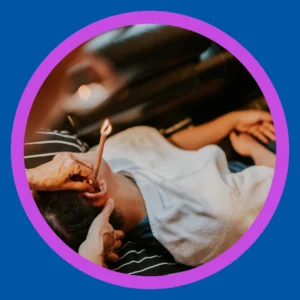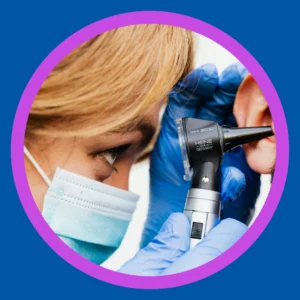Does Ear Candling Work For Ear Health?
Ear candling has gained attention as a home remedy for wax removal and overall wellness. But does ear candling work? Supporters claim it clears blocked ears, relieves sinus pressure, and improves hearing. However, science tells a very different story.
In this comprehensive guide, we’ll explore what ear candling is, what it promises, what actually happens during the process, and what the risks are. You’ll also learn safe, effective ways to manage earwax without risking your health.
What Is Ear Candling and Why Do People Use It?
Ear candling, sometimes called “ear coning,” involves inserting a lit, hollow candle into your ear canal. These candles are typically made of fabric soaked in beeswax or paraffin and measure about ten inches long.

To use them, you lie on your side and place the candle in your ear canal. A paper plate or protective shield is often used to catch dripping wax. Then, someone lights the exposed end of the candle and lets it burn for 10 to 20 minutes.
People use ear candling for many reasons. Some want to remove earwax naturally. Others hope to relieve tinnitus, sinus pressure, headaches, or even jaw pain. Some believe it can treat infections, improve lymphatic flow, and “clear the mind.” But these claims are based on myths, not medical science.
Discover where to find reputable ear wax removal near me.
The Origins of the Ear Candling Craze
Ear candling has roots in various alternative healing practices. Some believe it comes from ancient civilizations like the Hopi tribe, though the Hopi Tribe has publicly denied any connection. Regardless of origin, the modern trend is driven largely by anecdotal stories, online videos, and promises of “natural” wellness.
Alternative health websites and wellness influencers continue to promote ear candling as a gentle detox. However, reputable health organizations, including the FDA, have issued warnings about its use.
The Big Claim: Suction That Draws Out Earwax
Proponents of ear candling say the burning candle creates suction. This “chimney effect” supposedly pulls earwax, bacteria, and toxins out of the ear canal and into the candle. When they split the used candle open, they find a brownish residue they believe came from their ear.
This theory sounds convincing—until it’s tested. Studies using tympanometers (which measure pressure) show no vacuum effect inside the ear canal. No suction occurs during candling. The brownish residue? It appears even when the candle is not placed in the ear. It’s simply a mixture of melted wax and soot from the fabric tube.
Claim vs. Reality: Do the Proposed Benefits Hold Up?
People turn to ear candling to improve their health in several ways. Let’s examine these proposed benefits and compare them to the facts.
Myth: Ear Candling Removes Wax
Earwax is sticky and often impacted. It clings to the ear canal and requires pressure to dislodge. Ear candles don’t generate enough force to remove it. In clinical trials, earwax remained untouched after candling. In some cases, candle wax entered the canal instead, causing new blockages.
Myth: It Helps Hearing and Clears Sinuses
There is no biological connection between your ear canal and your sinuses that a candle could affect. Claims that ear candling enhances hearing or clears nasal passages are unsupported by anatomy or science.
Myth: It Relieves Pain, Tinnitus, or Vertigo
Many people with ear-related discomfort search for relief. But ear candling has not shown any consistent or measurable benefit for these conditions. Any relief people report may be due to placebo effects or unrelated changes in their symptoms.
Myth: It Detoxifies the Body
The idea that toxins leave your body through the ear canal is medically inaccurate. Your body detoxifies through the liver, kidneys, and digestive system—not your ears.
The Risks of Ear Candling: Why Experts Say No
Ear candling presents several risks, many of which can cause long-term hearing problems. Let’s look at the most common and serious ones.
Burns and Fire Hazards
Open flames pose obvious dangers. You could burn your face, hair, or ears. Candling at home, especially without a trained person, increases the risk of fire.
Melted Wax in the Ear
Dripping candle wax can enter the ear canal and solidify. This creates blockages that can impair hearing. Removing hardened wax often requires a hearing care provider or surgery.
Punctured Eardrums
Improper insertion of the candle or hot wax contact can rupture the eardrum. This leads to pain, hearing loss, and a long recovery period.
Temporary or Lasting Hearing Loss
Wax blockages or eardrum damage can reduce hearing clarity. In some cases, the damage is permanent or takes months to resolve.
Secondary Infections
Trapped wax or moisture promotes bacterial growth. Untreated infections may lead to serious ear complications.
A Real Patient Story: The Dangers in Action
One documented case involved a 50-year-old woman whose friend performed ear candling on her. When removing the candle, melted wax spilled into her ear. Doctors had to remove the wax under general anesthesia. The patient had a ruptured eardrum and mild hearing loss that did not improve one month later.
This case highlights a major risk of ear candling—injury caused not by the process itself, but by well-meaning people who don’t understand the dangers.
Learn ways to prevent hearing loss and reduce its impact.
What Does the FDA Say About Ear Candling?
The U.S. Food and Drug Administration has taken strong action against ear candles. It does not approve them for any medical purpose. It warns that ear candles can cause injuries and do not deliver on their advertised benefits.
The FDA has even seized shipments of ear candles and issued warning letters to companies that market them as medical devices. Their conclusion is simple: ear candling is unsafe and ineffective.
Research Doesn’t Support the Practice
Scientific studies consistently disprove the major claims of ear candling. In controlled experiments:
- No suction or pressure change occurred during candling.
- The temperature near the ear was too low to melt wax.
- Residue inside candles was from the candle, not the ear.
- No wax was removed from ears with wax buildup.
- Candle wax was deposited into ears that had no wax before the procedure.
These studies prove that ear candling doesn’t work. Worse, it puts your ear health at risk.
Find other solutions for itchy ears.

Better Ways to Manage Earwax Buildup
Earwax buildup is a common issue. But you have safe, effective options.
1. Over-the-Counter Ear Drops
These drops help soften earwax so it exits the ear naturally. Follow label instructions carefully.
2. Warm Water Rinses
A few drops of warm water can loosen wax. Tilt your head afterward to let it drain.
3. Avoid Inserting Objects
Cotton swabs and other tools push wax deeper. They increase the risk of impaction and injury.
4. Professional Removal
A hearing care provider can safely remove wax using suction, irrigation, or special tools.
5. Monitor Symptoms
Seek help if you have hearing loss, pain, discharge, or dizziness. These may signal a deeper issue.
Why Earwax Matters for Your Ear Health
Earwax may seem unpleasant, but it protects your ears. It traps dirt, keeps the canal lubricated, and wards off infection. Your body normally clears it during jaw movements like chewing.
Trying to remove it too often—or with the wrong tools—can upset this natural process and create more problems.
Bottom Line: Does Ear Candling Work?
In short, no. Ear candling does not remove wax. It does not clear infections. It does not improve hearing. Scientific studies, clinical reports, and government warnings all agree: it simply does not work.
Worse, it can seriously harm your ears, leading to infections, hearing loss, and permanent damage. If you’re worried about wax or ear pain, always consult a professional.

Need Safe Earwax Removal? Contact Stanford Hearing
Don’t risk your hearing with candles and unproven treatments. At Stanford Hearing, our trained hearing care providers offer safe, professional earwax removal and personalized care.
We understand the importance of ear health and the risks of alternative remedies. Let us help you hear better—safely and comfortably.
Call Stanford Hearing today to schedule your appointment. Let’s protect your ears together.
